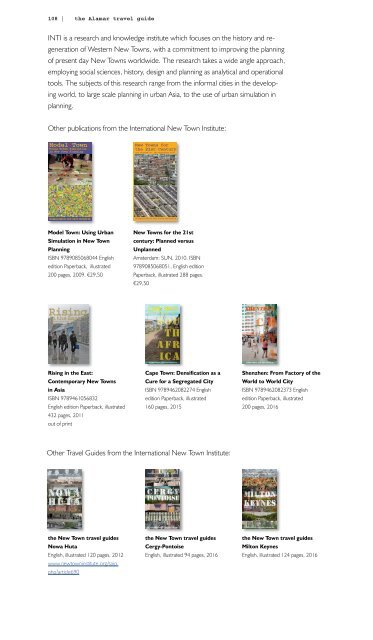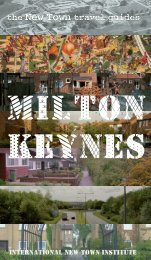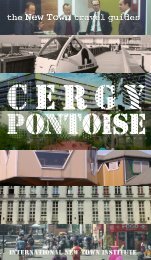You also want an ePaper? Increase the reach of your titles
YUMPU automatically turns print PDFs into web optimized ePapers that Google loves.
How to model new towns from scratch? Is it<br />
possible to simulate urban developments? And<br />
if so, are computer programmes of any help?<br />
How can urban simulation and serious gaming<br />
contribute to the urban design of our (new)<br />
cities?<br />
These questions are raised by the International<br />
New Town Institute (INTI). It seems<br />
logical that the computer is the perfect tool<br />
for designing new cities. The development of a<br />
city over time, the multitude of scenarios<br />
thinkable for each of the elements that constitute<br />
the city, these complications demand<br />
intelligent simulation applications to design<br />
and predict. Moreover, an ongoing sophistication<br />
and refinement is necessary to deal with<br />
the justified critiques on older, often extremely<br />
technocratic, simulation models.<br />
In recent years researchers have developed sophisticated<br />
models and there is an impressive<br />
and ongoing progress in the field of serious<br />
gaming and urban simulation.<br />
However, not all the simulation models in this<br />
book are dependant on the computer. Models<br />
that deal with decision processes or selforganization<br />
involving inhabitants can be<br />
low-tech. Simulation models, in the end, deal<br />
with human processes, they are part of a<br />
social and historical context, and they should<br />
not be autonomous projects. This is the subject<br />
of a surprising visual essay which brings<br />
the more technocratic questions back to<br />
basics: new towns are to live in.<br />
How to plan new cities? That is a central and crucial<br />
question discussed in this book by several authors.<br />
Is it possible at all to plan and design successful<br />
new cities? Or should we rather take a look at the<br />
history of ‘unplanned’ or ‘selforganized’ cities, to<br />
learn how to design informally? Are the planned and<br />
unplanned two opposite poles or are they actually in<br />
a symbiotic relation? How can elements like flexibility<br />
and changeability be incorporated into official<br />
planning? How can non-professional agents be involved<br />
in the process in a way that is credible and more<br />
than mere lip service?<br />
We need to understand the mechanisms of informalization<br />
so that they can be taken into account in the<br />
planning of future New Towns and the transformation<br />
of existing New Towns. The purely formal planning we<br />
are familiar with from the 20th century has resulted<br />
in cities that many critics now consider overdetermined.<br />
They are planners’ constructs that, in<br />
all their model-like perfection and correctness, have<br />
proved to be quite vulnerable. Often these cities are<br />
too much the embodiment of one idea, too much the<br />
product of one system, too much a reflection of one<br />
moment in time and too inflexible. The introduction<br />
of a degree of ‘unplannedness’ could improve this<br />
situation. A study of the unforeseen transformations<br />
of 20th Century New Towns and of ‘unplanned’ cities<br />
might yield the necessary know-how to achieve this.<br />
The design of future cities requires a form of planning<br />
that is lighter and at the same time richer and<br />
more varied. This book gives an overview of different<br />
approaches to analyze the diverse relations of the<br />
planned and the unplanned in existing<br />
New Towns and the lessons of selforganized<br />
cities for the planning profession.<br />
108 | the <strong>Alamar</strong> travel guide<br />
INTI is a research and knowledge institute which focuses on the history and regeneration<br />
of Western New Towns, with a commitment to improving the planning<br />
of present day New Towns worldwide. The research takes a wide angle approach,<br />
employing social sciences, history, design and planning as analytical and operational<br />
tools. The subjects of this research range from the informal cities in the developing<br />
world, to large scale planning in urban Asia, to the use of urban simulation in<br />
planning.<br />
model Model Town town<br />
using Using urban Urban simulation<br />
Simulation<br />
in new New town Town planning<br />
Planning<br />
inti INTI<br />
Other publications from the International New Town Institute:<br />
model Model Town town<br />
new New towns Towns for<br />
using Using urban Urban simulation<br />
Simulationthe<br />
21st century Century<br />
in new New town Town planning<br />
Planning the planned Planned vs. the unplanned Unplanned City city<br />
new New towns Towns for the 21st century Century<br />
the planned Planned vs. the unplanned Unplanned City city<br />
inti INTI<br />
New new towns Towns for<br />
the<br />
21st century Century<br />
the planned Planned vs. the unplanned Unplanned City city<br />
international INTERNATIONAL NEW newtown TOWN INSTITUTE institute international INTERNATIONAL NEW newtown TOWN INSTITUTE institute international INTERNATIONAL NEW newtown TOWN INSTITUTE institute<br />
international INTERNATIONAL NEW newtown TOWN INSTITUTE institute<br />
Model Town: Using Urban<br />
Simulation in New Town<br />
Planning<br />
ISBN 9789085068044 English<br />
edition Paperback, illustrated<br />
200 pages, 2009. €29,50<br />
New Towns for the 21st<br />
century: Planned versus<br />
Unplanned<br />
Amsterdam: SUN, 2010. ISBN<br />
9789085068051, English edition<br />
Paperback, illustrated 288 pages.<br />
€29,50<br />
Rising in the East:<br />
Contemporary New Towns<br />
in Asia<br />
ISBN 9789461056832<br />
English edition Paperback, illustrated<br />
432 pages, 2011<br />
out of print<br />
Cape Town: Densification as a<br />
Cure for a Segregated City<br />
ISBN 9789462082274 English<br />
edition Paperback, illustrated<br />
160 pages, 2015<br />
Shenzhen: From Factory of the<br />
World to World City<br />
ISBN 9789462082373 English<br />
edition Paperback, illustrated<br />
200 pages, <strong>2016</strong><br />
Other Travel Guides from the International New Town Institute:<br />
the New Town travel guides<br />
Nowa Huta<br />
English, illustrated 120 pages, 2012<br />
www.newtowninstitute.org/spip.<br />
php?article690<br />
the New Town travel guides<br />
Cergy-Pontoise<br />
English, illustrated 94 pages, <strong>2016</strong><br />
the New Town travel guides<br />
Milton Keynes<br />
English, illustrated 124 pages, <strong>2016</strong>




